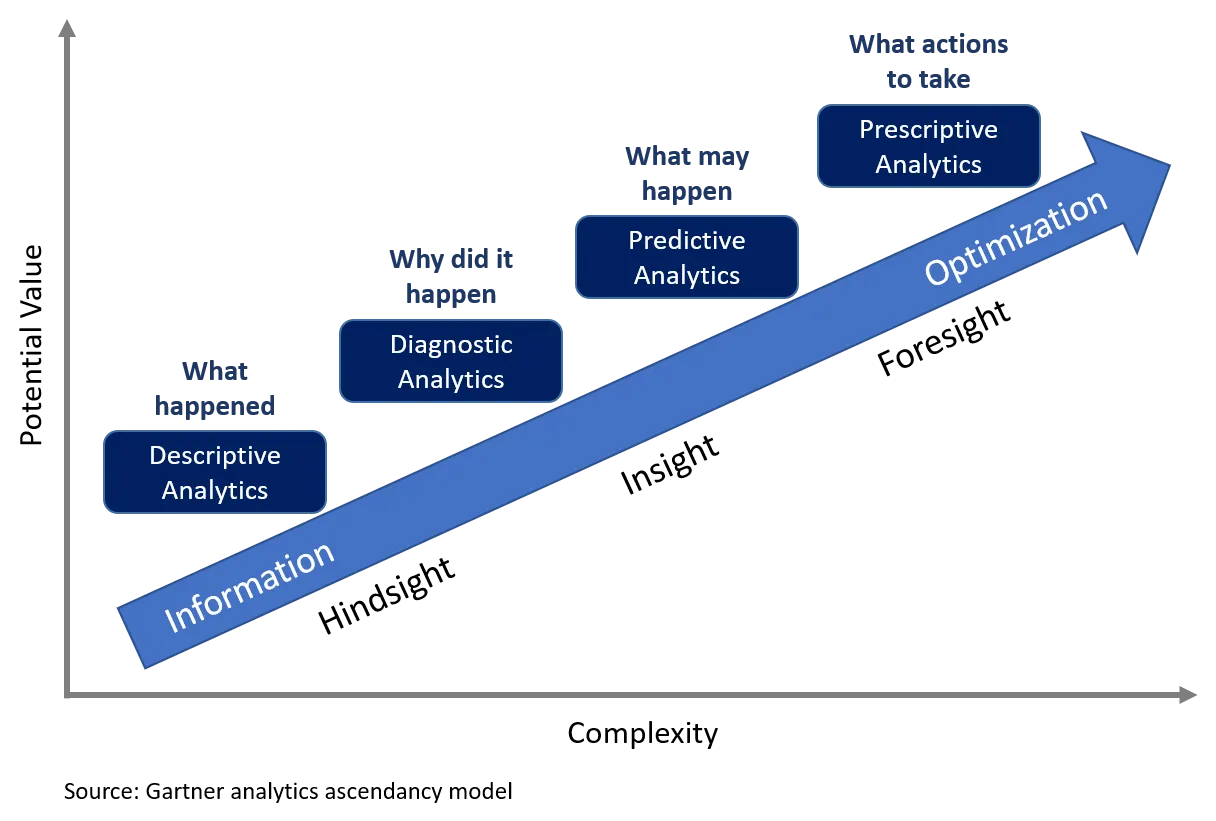
AI-Powered BI: Unlocking The Hidden Potential in Your Data
Artificial Intelligence has entered the corporate technology scene as a rapidly developing field, transforming business intelligence’s most tedious, disorganized, and repetitive tasks.
This article will give you an in-depth look into how AI can be used to make business intelligence more efficient, effective, and accessible.
From predictive to prescriptive data analytics
The integration of artificial intelligence in business intelligence streamlines the process of data analysis and reporting. Traditional business intelligence would have required a great deal of manual effort to gather, clean, and prepare the dataset. From there, the data scientist would have to liaise with company stakeholders, managers, and other decision-makers while creating the data dashboard to ensure that the organization communicates the correct information to their stakeholders.
But AI enhances efficiency at every step of this laborious process.

Accelerating the path to prescriptive analytics
Business intelligence was first used to visualize data, providing what we call “descriptive analytics” by answering the simple question: “what happened?” Then, an analyst would review the data to provide a diagnosis and understand the cause of any previous successes or failures. Now, the introduction of AI-powered BI tools can help forecast future events, trends, and behaviors, turning “descriptive” into “predictive” analytics. This typically uses statistical models and machine learning algorithms that analyze historical data to identify patterns and trends. Examples of this type of analytics include predicting customer churn, forecasting sales, and predicting inefficiencies in the supply chain.
However, while this type of analytics can leverage AI, it doesn’t make full use of its processing power, and with the help of machine learning and natural language processing, relevant AI-powered business intelligence programs can take predictive analytics a step further.
With prescriptive analytics, BI tools can now suggest actions and strategies to influence desired outcomes aside from predicting future trends. This form of analytics uses machine learning (ML) to analyze data, identify patterns, and present different courses of action. For example, retailers could use AI to prescribe the best price for a big range of products. In this case, ML algorithms are used to understand patterns in large datasets in real time. This allows businesses to adjust pricing for a large range of products, taking into account many different criteria to maximize profit and loyalty.
With the help of AI, business intelligence tools can not only accurately predict future trends and outcomes but also suggest action plans based on different scenarios to reach your desired objectives.
Read our blog to understand the difference between Business Intelligence and analytics
How can AI be used with BI?
Business Intelligence dashboards comprise visual representations of structured queries to the database. Whenever a stakeholder manipulates a graph, line chart, or table on the dashboard, BI tools use queries to retrieve data in the database using certain programming languages to visualize the data.
AI can boost your data visualization tools in many ways. From improving your data quality to uncovering hidden valuable insights or using Natural Language Processing (NLP) to query your data, AI will make data analysis faster, better, and cheaper.
Here are a few aspects to bear in mind when using AI-powered BI.
Data Governance
This whole ecosystem of data warehouses and dashboards is built on integrity and trust. The more widely used term for it would be data governance. This describes managing an organization’s data via a set of processes, policies, practices, and tools that ensure that data is safe, accessible, and usable.
Here are several steps to ensure that business operators can trust the insights they’ve gleaned from their data:
Protecting against Data Manipulation
Data manipulation is a critical concern. Whether done purposefully or not, manipulating data can lead to false or misleading results and ill-informed conclusions. Gross data manipulation may also lead to legal consequences, especially in cases of fraud.
To ensure that data is appropriately processed and examined, it’s essential to implement advanced monitoring systems and have regular audits for transparency. AI algorithms can detect any signs of tampering or manipulation outside the normally accepted variance.
Independent third parties may also conduct regular audits to ensure that data management practices are up to standard and free from any internal biases. It’s not uncommon for published reports to be audited as well.
Understanding Data Segmentation
Good data governance involves tailoring your data analysis to the user’s needs. Data segmentation divides a large dataset into smaller segments based on specific filters and criteria. For example, retail businesses can tailor their analysis to specific customer segments, geographic regions, product lines, or other relevant categories. Businesses can draw more powerful conclusions that allow for targeted decision-making by segmenting data.
Setting Security Practices
Having a strong foundation of security protocols helps protect sensitive data against unauthorized access or breaches. While this doesn’t directly impact the quality of analytics, it gives company stakeholders peace of mind with the knowledge that their confidential data is protected. Security clearances, for example, are common practice for companies to ensure that confidential company information is kept protected.
Having comprehensive security frameworks starts with multiple layers of protection. Encryption, access controls, and regular security training for staff should be done to safeguard business data and maintain a positive brand reputation.
Choosing The Right Tools
The right tools help a company deliver its data strategy faster, better, and cheaper. Top organizations are using artificial intelligence to cut down on the time and resources required to create good analysis. When choosing a BI tool, it’s important to consider factors such as:
- Compatibility with existing systems
- Scalability
- Ease of use
- Customizability
AI has amazing potential in business intelligence, so maintaining control over how this tool reads and processes your data will be invaluable to any company looking to extract valuable insights and accurate predictions.
Segmenting the risks
While AI introduces numerous advantages, inherent risks arise from this new technology, including lack of transparency, privacy concerns, and bias in the analytics.
Businesses must assess the level of risk they are willing to accept in different areas. Sometimes, a 1% chance of error in your data is acceptable, especially for the retail sector. In this case, data governance practice may be a little less stringent, prioritizing a quick rollout over accuracy. However, if an organization uses data for operational or financial purposes, then accuracy becomes a far higher priority over a quick rollout.
Whatever the case, organizations can still accelerate the process with predictive and prescriptive AI, but different projects will require different implementation methods and levels of use.
Using BI as a conversational tool
Because Artificial Intelligence is incredibly dynamic, it allows users to create and edit their dashboards in real time.
By leveraging natural language processing (NLP), analysts and stakeholders, even users without prior programming experience can input queries directly into the BI tool and create dashboards for their needs. This lack of required knowledge frees up data scientists and analysts to work on other projects.
This is the essence of data democratization – unlocking the potential of your data by giving access to all possible stakeholders.
The advent of AI in business intelligence has revolutionized the creation of dashboards, making them accessible to users regardless of their technical background. Even better, these AI-powered tools are often built with the user first in mind. This means that tools are armed with intuitive interfaces that make it simple for users to select the right data points and apply the appropriate analysis techniques.
Uncovering insights and patterns faster
Through AI queries, data scientists are able to transform the landscape of business intelligence by rapidly processing and analyzing large datasets. AI algorithms, in particular, are adept at sifting through large amounts of data faster than any human. Using traditional data science methods, they can identify anomalies, pattern changes, and even correlations that may go unnoticed.
While it may require human guidance, AI has led to relentless industry improvements. Organizations can quickly adapt to emerging market trends with real-time market analytics and adjust their strategies in real time.
Creating faster forecasts
With a near-instantaneous ability to process and interpret data, artificial intelligence can create forecasting models with greater speed and accuracy. Conventional methods of forecasting are often slower than machine learning and artificial intelligence.
Don’t forget that artificial intelligence can also scrape the internet for various data points, including demographics, price changes, and consumer sentiment. With so much consumer data and market information found online, developing effective forecasts becomes a much easier task, so long as data remains accurate.
Enhancing analysis with Machine Learning
A 2023 survey by Statista shows that 44.87% of small and large businesses have adopted machine learning in some capacity. The businesses that will survive in the long run are willing to adopt this technology and experiment and refine their infrastructure and data architecture.
Analytical models are refined over time as algorithms continually learn from new data inputs. Thus, it becomes crucial that businesses adopt good data hygiene and governance.
Benefits of AI-powered BI
Across industries, business intelligence is set to redefine what it means to make good strategic decisions. Key in this transition will be AI, whose perpetual nature creates a relentless environment for companies seeking a competitive advantage. Here are three major benefits that AI presents to all organizations, both small and large:
Speed and Accuracy
AI algorithms analyze data faster and better than traditional methods. These algorithms can scrape, scour, and process large batches of data in seconds. In the right hands, faster analytics allows businesses and organizations to serve more end users, improving your market position and balance sheet.
Wider Data Accessibility
AI adoption is crucial for data democratization and when data is accessible across departments, management is better able to take on a more integrated, responsive approach to solving business challenges. Key decision-makers can respond more quickly to market changes, customer needs and internal challenges and keep track of key performance indicators more accurately. Tools can facilitate easy access and interpretation of data and empower these employees to conduct their analyses, leading to a more efficient workflow.
Proactive Business Strategies
With more comprehensive access to customer and internal data, organizations can take on a more proactive approach to their communications. Traditionally, businesses rely on customer feedback to report issues before they act. With predictive analytics and AI, organizations can identify possible issues pre-emptively and prescribe a corresponding course of action. Taking on a more proactive approach improves the customer experience and increases the average net promoter score.
Download our guide to unlock your analytics by harnessing insights at scale
How to get started
Using Artificial Intelligence in your business intelligence endeavors requires a carefully laid out, methodological plan. Here’s a guide to help you begin your journey with AI-powered business intelligence:
1. Define Your Objectives and Requirements
Before anything else, lay out a clear and detailed plan of what you want to achieve with your intelligence endeavors. Assess your current situation and evaluate your existing data infrastructure, team skills, and the specific business challenges you aim to address with AI.
2. Accelerate your underlying data with the right architecture
In 2023, businesses rushed out of the gate to begin implementing AI into their ecosystem but lack of experience often lead to poor infrastructure and data governance. The most successful organizations will often fail quickly and rebound from the lessons learned.
This step highlights investing in the right infrastructure to support AI-powered business intelligence. Whether it’s upgrading hardware or networking capabilities, be ready to invest to support AI.
3. Ensure your data is reliable
Generated insights are only as good as your dataset, tools, and management practices. Data segmentation, completeness, and hygiene are also important factors to consider.
Before using any new tools, ensure that they are tested rigorously. For example, if implementing conversational AI, your data team could ask the same question in different ways. Doing so sheds insight on what type of performance and quality stakeholders should expect from their AI tools.
4. Get an AI-powered BI that already has models in place
If possible, search for business intelligence tools already implementing artificial intelligence and machine learning programs. Building customized AI models is expensive and time-consuming. Intelligence tools with pre-existing AI models simplify integration and reduce the need for further tinkering, allowing the business to focus on implementation.
Discover the power of Espresso + Veezoo – combine AI with faster insights
5. Pick your battles when implementing
The final step is to create tangible business strategies. Ideally, one would begin with a small, high-impact project tied to a specific department. As an example, you may want to start projects tied to your customer data. These types of projects do not require highly accurate consumer information but, if improved, can translate well into profit.
From here, iterations could be made to the implementation process, with an acute focus on regularly monitoring the performance of your AI-powered BI systems as well as fostering a data-driven culture around technology.
How will BI tools evolve?
Business intelligence tools have been rapidly evolving even before artificial intelligence became a buzzword in 2023. BI programs have come a long way from when intelligence tools had only concerned themselves with read-only data and simple tables from the early 2000s. These days, we can edit and interact with full-blown dashboards and data models. We can create multiple views and filter out more important information.
Reflecting on the growth trajectory from the early 2000s and seeing the trends of technology today, we can make educated predictions on how BI tools will continue to evolve in the future, and power corporate growth.
Generative AI capabilities
Future BI tools will likely incorporate generative AI capabilities, allowing them to create and modify dashboards on the fly without requiring extensive technical knowledge. Generative AI may create comprehensive data narratives and insights from these modified dashboards.
Self-Service BI tools
We advocate heavily for data democratization. Being data literate improves decision-making and creates a more productive workforce. The trend towards self-service business intelligence will only empower users to create their own queries, reports, and visualization. As users throughout the organization learn to create more personalized, relevant dashboards, they will be able to iterate their points better in arguments and have better-thought conversations.
Increasing Demand for Computational Power
The third trend we foresee for BI tools is the increased demand for computational power, particularly as a result of AI integration. This means that more money will flow into AI and data storage services as businesses seek to gain a competitive advantage.
Discover 5 AI-fueled trends for data-driven organizations to watch in 2024
How Exasol Can Help
The future of BI is heavily tied to advanced AI integration and user-friendliness. These tools will not only improve data accessibility but also provide more actionable insights and foster a more data-driven culture within organizations.
Exasol’s Espresso integrates with AI-powered BI tools like Veezoo to bring you better insights, faster and cheaper. Our BI accelerator ensures you get your data in real time to enable fast data-driven decisions when Veezoo allows anyone in the business to gather better insights, regardless of their technical level.
Through improved database performance and reduced maintenance and training costs, Exasol Espresso has returned a 300%+ ROI, leading to savings of up to seven figures for organizations with an unmatched price-performance ratio.
Speak to a member of the Exasol team today to find out to find out more about how Exasol can unlock your data with Espresso today.





